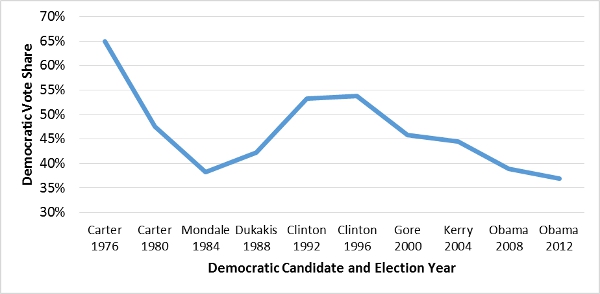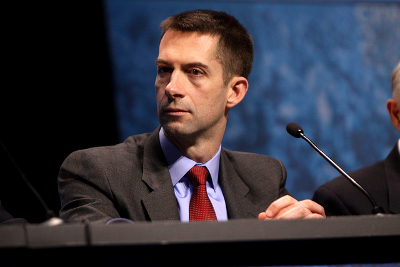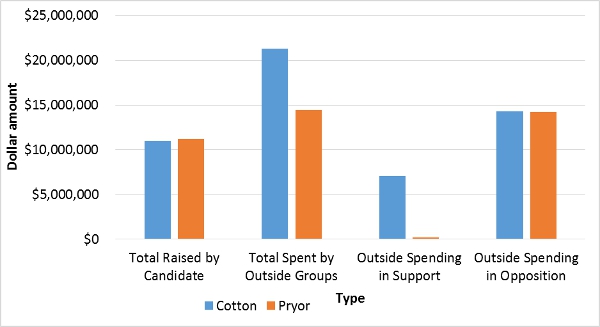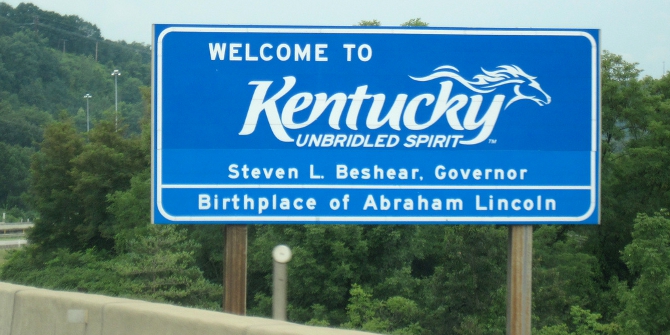 As part of USAPP’s series examining key 2014 Senate midterm election races, Greg Shufeldt writes that the Arkansas’ election is unusual in its closeness, given the state’s recent swing towards the Republican Party. He argues that while massive spending by outside groups has helped Democrat Mark Pryor to stay in the fight, the polls are squarely behind his opponent, Tom Cotton, who has been called the ‘future of the GOP’ by some commentators.
As part of USAPP’s series examining key 2014 Senate midterm election races, Greg Shufeldt writes that the Arkansas’ election is unusual in its closeness, given the state’s recent swing towards the Republican Party. He argues that while massive spending by outside groups has helped Democrat Mark Pryor to stay in the fight, the polls are squarely behind his opponent, Tom Cotton, who has been called the ‘future of the GOP’ by some commentators.
The 2014 Senate race between incumbent Democrat Mark Pryor and Republican Congressman Tom Cotton is very much a reflection of the national mood and broader electoral trends, yet it is also proving to be a pivotal moment in Arkansas’ political history. In many ways, this race has no business being as close as it is. Democrats, like Mark Pryor, are becoming endangered species in the South.
Arkansas is one of the last Southern states to flip from Democratic, as part of the old Solid South, to Republican. Democrats have suffered substantial losses in recent state elections wiping away generations of dominance. Republicans captured control of both chambers of the State Legislature in 2012 for the first time since Reconstruction. Figure 1 shows that as recently as 2006, Democrats controlled more than 75 percent of the seats in both chambers.
Figure 1 – Percent of the State Legislature Controlled by Democrats

Republicans are asserting their dominance in Arkansas in national elections as well. Since 2012, Republicans have controlled and are generally favored to continue to hold all four seats in Congress. In 2010, moderate incumbent Senator Democrat Blanche Lincoln lost to Republican John Boozman by more than 20 percent. President Obama performed well behind other Democratic candidates in both 2008 and 2012, losing both elections by more than 20 percent, as shown in Figure 2. Whether this is due to Obama’s race or changing demographics in Arkansas as suggested in a recent New York Times piece, it is clear that the clock is ticking on Democrats’ ability to win statewide elections in the near future.
Figure 2 – Percentage of the Vote Received by Democratic Presidential Candidates in Arkansas

Why is this race close? The Pryor and Cotton campaigns, as well as outside groups, have spent more than $50 million on this race thus far. Arkansas has been exposed to an onslaught of ads unlike anything in recent memory as most elections in the state are rarely competitive. The Pryor campaign aired their first ad more than a year and a half before the election. Both sides have effectively used an early and consistent barrage of ads to frame the election as a choice for voters.

On paper, Pryor is the archetype for success for Democrats to have any sort of future in states like Arkansas. He is moderate Democrat with a strong family lineage in Arkansas politics as the son of former Senator and Governor David Pryor. Pryor seems to excel in retail politics, the face to face interaction with everyday Arkansans that helps him overcome belonging to the party that is growing out of favor. Pryor’s biggest albatross or vulnerability this election has been his party and more specifically President Obama, whose approval ratings in Arkansas lag well behind an already flaccid national average. Pryor has been cast as an out-of-touch liberal who is simply a rubber stamp for President Obama’s agenda.
The Cotton campaign and independent groups have consistently reminded voters that Pryor “cast the deciding vote” for Obamacare and votes with President Obama “90 percent of the time.” For just a small sample, see here, here, here, and here. In a recent debate, Cotton managed to work President Obama into almost every one of his answers. Similar to quips against former New York City Mayor Rudy Giuliani, Cotton’s campaign has frequently followed a mantra of noun, verb, Obama. It has proved to be an effective strategy.
Pryor has not helped matters by trying to defend his record while running away from his party and an unpopular President. For example, Pryor released an ad touting some of the popular components of the Affordable Care Act without mentioning it or Obamacare by name – only indicating that he helped “pass a law.” Even though Arkansas leads all states with the largest drop in percent uninsured, more than 10 percent according to a recent Gallup poll, since the passage of the Affordable Care Act, President Obama and Obamacare remain deeply unpopular with voters.
Meanwhile, Cotton has been called the “future of the GOP” by the National Journal and a “conservative superstar” by The Atlantic. Cotton’s pedigree has drawn attention as a candidate with both a military background and an Ivy League education. His bona fide conservative credentials as a member of Congress have helped appeal to both the Tea Party activists and financial backers of the Republican Party.

Pryor has been successful with the help of outside groups, such as Senate Majority PAC, Patriot Majority USA, and the Democratic Senatorial Campaign Committee, painting Cotton as a dangerous ideological extremist beholden to wealthy out-of-state interests like the Koch Brothers. At the same time, this ideological purity has provided fodder for forceful attacks on controversial votes even breaking with the rest of Arkansas’ all Republican Congressional delegation on issues such as the farm bill, medical and disaster relief, and student loans. As a result, the conservative, yet pragmatic, voters of Arkansas have been slow to warm to Cotton.
Of the total $50 million spent on this race, more than $35 million of that has come from outside groups. Groups supporting Cotton have outspent groups supporting Pryor by a 2 to 1 margin. Democratic and liberal groups have spent almost all of their money exclusively attacking Congressman Cotton. This Republican and conservative advantage in money has allowed Cotton to receive both positive messages supporting his candidacy and attacking Pryor. Pryor, meanwhile, has been forced to play defense the whole election. While the “best defense may be a good offense” for the Pryor campaign, it has been an uphill fight to win due to an unpopular party and President.
Figure 3 – Campaign Spending by Candidates and Outside Groups

As the election nears, the dynamics clearly are in place for a Cotton victory. Polling has not shown Pryor with any sort of lead since September, and more recent polls are showing Cotton with an advantage outside of the margin of error. Pryor and the Democrats’ best hope is that turnout will be surprisingly high. Only 48 percent of registered Arkansas voters turned out in 2006 and 2010, the last two midterm elections. Democrats hope that a ballot initiative to raise the minimum wage might mobilize and boost turnout among traditional Democratic constituencies. The initiative is expected to pass easily based on widespread support. Democrats also received a boost when the state’s stringent photo identification law was unanimously struck down recently by the State Supreme Court.
The Cotton-Pryor race has been more contested and expensive than any race in either of those cycles. Both sides have been trading well-financed punches for more than year with the help of powerful out-of-state forces. Pryor is the ideal type of candidate for Democrats in Arkansas, yet it seems likely that an increasingly unpopular President and a party that has fallen out of favor with most state voters may be too much to overcome.
This article is part of USAPP’s expert commentary on key 2014 Senate midterm races. Click here to read commentary on other key states.
Featured image credit: J. Stephen Conn (Flickr, CC-BY-NC-2.0)
Please read our comments policy before commenting.
Note: This article gives the views of the author, and not the position of USApp– American Politics and Policy, nor of the London School of Economics.
Shortened URL for this post: http://bit.ly/1tAEf9G
_________________________________
 Greg Shufeldt – University of Arkansas at Little Rock
Greg Shufeldt – University of Arkansas at Little Rock
Greg Shufeldt is currently an Assistant Professor at the University of Arkansas at Little Rock. Within American Politics, his research and teaching interests include state and local politics, political parties, and campaigns and elections. His current research is focused on the conceptualization, measurement, and normative implications of the quality of democracy in the American States.






